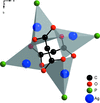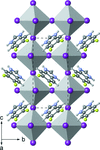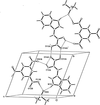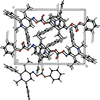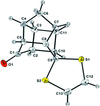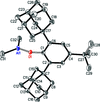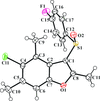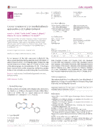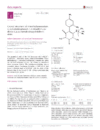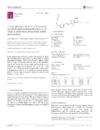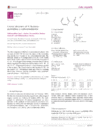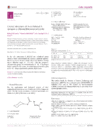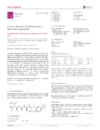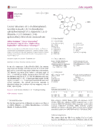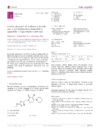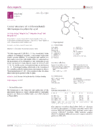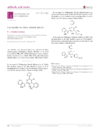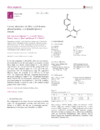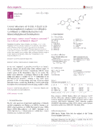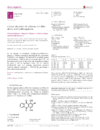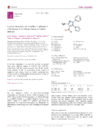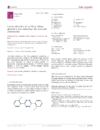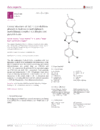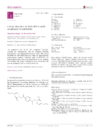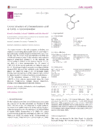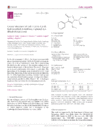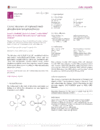issue contents
October 2014 issue

Cover illustration: The molecular structures of the molybdenum(II) cyclopentadienyl complexes [Mo(C5H5)(COCH3)P(CH3)2(C6H5)(CO)2], (1), and [Mo(C5H5)(COCH3)P(C2H5)(C6H5)2)(CO)2], (2), exhibit a four-legged piano-stool geometry with trans-disposed carbonyl ligands. The steric demands of the different phosphine ligands in (1) and (2) have a minor effect on bond lengths and angles within the complex molecule whereas the crystal packing in both structures is markedly different, with the acetyl oxygen atom playing a crucial role as an acceptor of non-classical C---H...O hydrogen bonds. See: Whited, Hofmeister, Hodges, Jensen, Keyes, Ngamnithiporn & Janzen [Acta Cryst. (2014). E70, 216-220].
research communications
Download citation


Download citation


In the hydrogen-bonded structure of the Mg salt of the herbicide (2,4-dichlorophenoxy)acetic acid (2,4-D), the metal atom is octahedrally coordinated by a monodentate 2,4-D ligand and five water molecules, with a 2,4-D− counter-anion and half a solvent water molecule completing the crystal structure.
CCDC reference: 1021287
Download citation


Download citation


The coordination geometry around the central CoII ion is unexpectedly different from that for the co-crystal of the title molecule with anthranilic acid.
CCDC reference: 1021534
Download citation


Download citation


The title compound comprises a 2-iminopyridine ring fused with a cyclooctane ring, which adopts a twist boat–chair conformation. Intermolecular C—H⋯N interactions form  (14) ring motifs and molecules are further connected by weak C—H⋯π interactions.
(14) ring motifs and molecules are further connected by weak C—H⋯π interactions.
CCDC reference: 1021949
Download citation


Download citation


In 1,8-dibenzoyl-2,7-diphenoxynaphthalene, the planes of the benzene rings of the four naphthalene substituents are almost perpendicular to that of the naphthalene core.
CCDC reference: 1022493
Download citation


Download citation


In the title compound, the silver(I) ions are coordinated by four triphenylphosphane ligands and two 2,2-diallylmalonate anions in a μ4-(κ6O1,O3:O3:O1′,O3′:O1′) mode, setting up an Ag4O8P4 core.
CCDC reference: 1021407
Download citation


Download citation


The bicyclic aromatic benzimidazolium cation stabilizes the layered perovskite structure comprising inorganic {[SnI4]2−}n sheets. A difluoro-substitution of the organic cation demonstrates the structural versatility of the new approach.
Download citation


Download citation


The crystal structures of the co-crystal adducts of 3,5-dinitrobenzoic acid with 4-aminosalicylic acid (a 2:2:0.4-hydrate) and with 2-hydroxy-3-(1H-indol-3-yl)propenoic acid (a 1:1:1 d6-DMSO solvate) show, respectively, polymeric and hexamolecular hydrogen-bonded and π–π-bonded structures
Download citation


Download citation


The crystal structure of the title compound consists of a polymeric chain of SmIII cations and nitrate anions, cross-linked in two dimensions with an organic ligand.
CCDC reference: 1023116
Download citation


Download citation


The title compound crystallized as racemic tandem OO—H⋯O=C hydrogen-bonded dimers stacked along [100] in the space group P . This is the first crystallographically characterized example of a hydroperoxide obtained from the autoxidation of a Diels–Alder adduct of a 2-vinyl five-membered heterocycle.
. This is the first crystallographically characterized example of a hydroperoxide obtained from the autoxidation of a Diels–Alder adduct of a 2-vinyl five-membered heterocycle.
CCDC reference: 1022638
Download citation


Download citation


A one-dimensional chain formed by potassium bridged by μ2-O-dimethylacetamide is reported. This represents a small class of dimethylacetamide complexes with oxygen bridging two metal centers.
CCDC reference: 1022963
Download citation


Download citation


The title compounds are the 3-ethyl, (I), and 3-isopropyl, (II), derivatives of (1-methyl-2,6-diphenylpiperidin-4-ylidene)amino phenyl carbonate. The main difference in the conformation of the two compounds is the angle of inclination of the phenoxycarbonyl ring with respect to the piperidine ring mean plane, with a dihedral angle of 2.05 (8)° in (I) and 45.24 (13)° in (II).
Download citation


Download citation


The title salts, C8H13N4+·Cl−, (I), and C8H13N4+·NO3−, (II), contain linked pyridinium–piperazine heterocycles. In the crystal of (I), weak N—H⋯Cl interactions lead to zigzag chains along [100] while in the crystal of (II), bifurcated N—H⋯(O,O) hydrogen bonds and weak C—H⋯O interactions collectively link the components into infinite chains along [100].
Download citation


Download citation


The copper(II) ion of the anhydrous form of bis(sarcosinato)copper(II) exhibits a [4 + 2] coordination sphere with four shorter equatorial bonds to the N and carboxylate O atoms of two sarcosinate anions, and two longer axial bonds to O atoms of neighboring complexes, leading to a sheet structure parallel to (001).
CCDC reference: 961026
Download citation


Download citation


The MnIII ion in the title compound shows a slightly distorted octahedral coordination geometry with two O and four N atoms of the pyrrolyl derivative ligand. In the crystal, intermolecular N—H⋯O hydrogen bonds between the pyrrole group of the ligand and the uncoordinated nitrate ion give a chain structure along [10 ].
].
CCDC reference: 1023763
Download citation


Download citation


In the crystal, the benzamide molecules are linked by N—H⋯O hydrogen bonds to generate tetramers with an approximate square-prismatic shape, which appears to correlate with the tetragonal crystal symmetry.
CCDC reference: 1023362
Download citation


Download citation


The crystal structures of the title compounds are compared, showing molecular parameters that reflect the relative steric pressure of their respective phosphine ligands. Their supramolecular properties are distinct but in both cases are organized around short C—H⋯O contacts involving the acetyl ligands.
Download citation


Download citation


The title salt crystallized with two anions and two cations in the asymmetric unit, together with three water molecules. In the crystal, the anions are linked via O—H⋯O hydrogen bonds, involving the water molecules, forming chains along [100] and the cations are linked to these chains by N—H⋯O hydrogen bonds.
CCDC reference: 1024182
Download citation


Download citation


The title molecule, a rare example of a π-conjugated triazene, crystallized with two independent molecules in the asymmetric unit. In the crystal, the two independent molecules stack head-to-tail probably due to the presence of the dipole moment of the meta nitro group.
CCDC reference: 977732
Download citation


Download citation


In the title compound, seratrodast has crystallized with trometamol to form a monohydrated salt. The carboxylic acid group of seratrodast has transferred its proton to the amino N atom of trometamol.
CCDC reference: 975488
Download citation


Download citation


In the nearly planar 2-pentyloxybenzamide molecule, there is an intramolecular N—H⋯O hydrogen bond involving one amide proton and the ether oxygen. In the crystal, pairs of N—H⋯O hydrogen bonds organize molecules into inversion dimers lying in two planes, (121) and (1 1).
1).
CCDC reference: 1024316
Download citation


Download citation


The PrIII cation is surrounded ninefold by five sulfate groups (two monodentate and three chelating) and by one water molecule. The [Pr(SO4)5(H2O)] groups are arranged in sheets parallel to (010); two crystal water molecules and two ethylenediammonium cations connect the sheets via O—H⋯O and N—H⋯O hydrogen bonds into a three-dimensional framework structure.
CCDC reference: 1024418
Download citation


Download citation


The first five-membered group-VI 3-ferrocenyl heterocycle bearing a further aromatic substituent at the 1′ position of the ferrocene backbone is reported.
CCDC reference: 1018554
Download citation


Download citation


In the title compound the Mn Nnitride distance is 1.516 (4) Å. The Mn atom is displaced from the plane defined by the four equatorial nitrogen atoms toward the nitride ligand by 0.3162 (6) Å.
CCDC reference: 1024311
Download citation


Download citation


The pentacycloundecane cage derivative exhibits unusual Csp3—Csp3 single bond lengths ranging from 1.495 (3) to 1.581 (2) and strained bond angles as small as 89.29 (12) and as large as 115.11 (11)°.
CCDC reference: 832292
Download citation


Download citation


In the title compound, the dihedral angle between the plane of the benzofuran ring and the 4-fluorophenyl ring is 82.45 (4)°. In the crystal, molecules are linked via three different pairs of C—H⋯O hydrogen bonds, forming chains along [001] and enclosing two  (10) and one
(10) and one  (12) ring motifs.
(12) ring motifs.
CCDC reference: 1021511
Download citation


Download citation


In the square-planar [Ni(C14H11FNO)2] complex, weak C—H⋯F and C—H⋯π interactions play an important role in the molecular self-assembly, resulting in the formation of 2D molecular sheets which are stacked along the b axis.
CCDC reference: 1024161
Download citation


Download citation


In the title molecular salt, the two rings of the barbiturate anion are inclined to one another by 43.40 (3)°. In the crystal, the cations and anions are linked via N—H⋯O hydrogen bonds, forming zigzag chains along [10 ], which in turn are linked by O—H⋯O and C—H⋯O hydrogen bonds, forming slabs lying parallel to (10
], which in turn are linked by O—H⋯O and C—H⋯O hydrogen bonds, forming slabs lying parallel to (10 ).
).
CCDC reference: 1008376
Download citation


Download citation


In the crystal, molecules are linked by N—H⋯O hydrogen bonds, forming inversion dimers, which are linked by a further N—H⋯O hydrogen bond, forming chains along [100]. There are intra- and intermolecular C—H⋯π interactions present, the latter linking the chains to form a three-dimensional supramolecular structure.
CCDC reference: 1024391
Download citation


Download citation


In the title molecule, C21H20ClF2NO2, the piperidine ring adopts a slightly-distorted boat conformation, the two benzene rings form a dihedral angle of 87.43 (1)° and a weak intramolecular C—H⋯π interaction is observed. In the crystal, weak C—H⋯O hydrogen bonds and weak C—H⋯π interactions connect molecules forming a three-dimensional network.
CCDC reference: 1026047
Download citation


Download citation


The highlighted ruthenium complex forms discrete dimers by π–π stacking interactions and hydrogen bonds. This combination of interactions results in an unusual nearly face-to-face π–π stacking mode.
CCDC reference: 1025408
data reports
metal-organic compounds
Download citation


Download citation


Download citation


Download citation


Download citation


Download citation


Download citation


Download citation


Download citation


Download citation


Download citation


Download citation


Download citation


Download citation


Download citation


Download citation


Download citation


Download citation


Download citation


Download citation


organic compounds
Download citation


Download citation


Download citation


Download citation


Download citation


Download citation


Download citation


Download citation


Download citation


Download citation


Download citation


Download citation


Download citation


Download citation


Download citation


Download citation


Download citation


Download citation


Download citation


Download citation


Download citation


Download citation


Download citation


Download citation


Download citation


Download citation


Download citation


Download citation


Download citation


Download citation


Download citation


Download citation


Download citation


Download citation


Download citation


Download citation


Download citation


Download citation


Download citation


Download citation


Download citation


Download citation


Download citation


Download citation


Download citation


Download citation


Download citation


Download citation


Download citation


Download citation


Download citation


Download citation


Download citation


Download citation


Download citation


Download citation


Download citation


Download citation


Download citation


Download citation


Download citation


Download citation


Download citation


Download citation


Download citation


Download citation


Download citation


Download citation


Download citation


Download citation


Download citation


Download citation


Download citation


Download citation


Download citation


Download citation


Download citation


Download citation




 journal menu
journal menu















